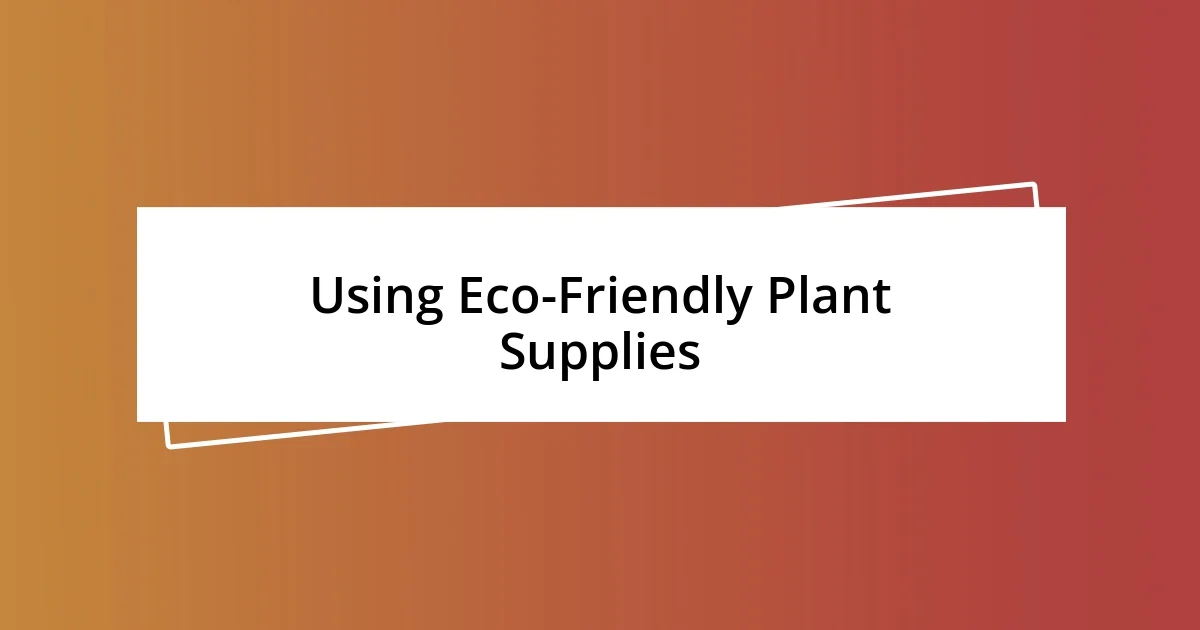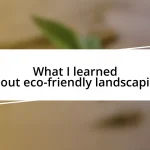Key takeaways:
- Choosing the right indoor plants requires consideration of light, humidity, and maintenance levels to ensure they fit your lifestyle and environment.
- Sustainable plant care practices such as using natural fertilizers, monitoring water usage, and grouping plants based on their needs can enhance plant health and reduce environmental impact.
- Sharing your plant journey with others fosters community, inspires and connects people over a shared love for gardening and sustainability.

Choosing the Right Indoor Plants
Selecting the right indoor plants can feel overwhelming, especially with the endless options available. I remember when I first started my plant journey; I found myself drawn to vibrant colors and exotic shapes, only to learn later that some of those beauties required more care than I was able to provide. Have you ever felt captivated by a plant, only to discover it wasn’t the right fit for your lifestyle?
It’s essential to consider factors like light, humidity, and available space when choosing your plants. For instance, I learned the hard way that placing a tropical plant in a low-light corner led to disappointment; it drooped sadly while I watched. You want a thriving plant that brings joy, not one that adds to your worries.
Another tip is to think about the level of maintenance you’re ready to commit to. I’ve found that succulents not only resonate with my aesthetic preferences but also require far less watering than some other varieties. Isn’t it fascinating how the right choice can change your experience? With a little research and self-reflection, you can find your perfect green companion that truly fits your home and life.

Understanding Sustainable Plant Care
Sustainable plant care goes beyond just watering and dusting leaves; it encompasses a holistic approach to nurturing your plants while being mindful of our environment. I used to think that care meant following a regimented schedule, but I quickly learned the impact of environmental factors like climate and seasonality. Embracing a more intuitive method allowed me to better understand the needs of my plants, leading to more vibrant growth and a healthier home.
Here’s what I’ve found helpful in practicing sustainable plant care:
- Use natural fertilizers: I switched to compost and organic options, and I’ve noticed a dramatic improvement in plant health.
- Monitor water usage: Instead of watering blindly, I check the soil’s moisture level. Overwatering can be detrimental, and it feels good not to waste water unnecessarily.
- Group plants by needs: I cluster my plants based on their light and humidity requirements, which makes care more efficient and effective.
- Repurpose materials: I’ve even found ways to reuse items like glass jars for propagation, adding a creative touch while being sustainable.
- Stay informed: Learning about each plant’s specific needs has been a game changer for me. It’s empowering to know how to cater to their unique lifestyles.

Using Eco-Friendly Plant Supplies
Using eco-friendly plant supplies not only supports a healthy environment but also enhances our experience as plant lovers. When I first transitioned to sustainable supplies, I was a bit skeptical. Would they really make a difference? To my pleasant surprise, I discovered that eco-friendly soil and fertilizers are not only better for the planet but also worked wonders for my plants. The first time I mixed my own compost, I felt a sense of pride and connection that store-bought fertilizers simply couldn’t provide.
Another area where I’ve seen significant improvement is in the choice of pots and containers. I switched from plastic to biodegradable options made from materials like bamboo and coconut coir. At first, I thought these containers might be less durable, but they’ve actually held up quite well. Plus, it’s gratifying to know that they won’t contribute to landfill waste. When I repotted my fern into a coir pot, watching it thrive felt like a small victory for both of us—a living testament to making mindful choices.
Lastly, engaging in sustainable practices ultimately brings a certain peace of mind. Using eco-friendly supplies fosters a deeper connection with nature, which I cherish. Have you ever felt that joy from holding a rich soil blend in your hands or witnessing a plant flourish in a biodegradable pot? It reminds me how every choice we make impacts our little green companions and our environment. I’ve learned that sustainability doesn’t just benefit plants; it enriches our lives as well.
| Eco-Friendly Supplies | Traditional Supplies |
|---|---|
| Biodegradable pots (e.g., coir, bamboo) | Plastic pots |
| Organic fertilizers (e.g., compost) | Synthetic fertilizers |
| Natural pest control methods | Chemical pesticides |
| Reusable plant supports (e.g., bamboo stakes) | Single-use plastic supports |

Tips for Effective Indoor Gardening
One essential tip I’ve picked up is to observe the microclimate in your home. I remember placing my snake plant near a window expecting it to thrive, only to see it languish. After some research, I realized that the direct sunlight was too intense for it. Now, I regularly assess light patterns in my space to match each plant’s needs—this simple act has made a world of difference. Isn’t it fascinating how a little attention to detail can transform your indoor garden?
I’ve also found that creating humidity trays can work wonders, especially during dry months. Simply fill a shallow dish with pebbles and water, then set your pots on top. This method not only boosts humidity for plants that love moisture, like my peace lily, but it also adds a decorative element to my space. Have you ever noticed how a little innovation can spark joy? It’s those small touches that make indoor gardening feel more personal and fulfilling.
Lastly, I can’t stress enough the importance of rotating your plants. This habit, which I embraced after noticing that one side of my pothos was much lusher than the other, encourages even growth and can prevent the plant from leaning toward light sources. I find myself chatting with my plants as I turn them, almost like a friendly conversation. It brings me so much joy to witness them thrive in every nook of my home. Have you tried rotating your plants? You might be surprised by the positive changes!

Creating a Sustainable Plant Environment
Creating a sustainable plant environment starts with understanding your home’s unique ecosystem. When I moved my spider plant into a bright, indirect light corner, I witnessed a transformation that made me feel more connected to my space. It’s amazing how tuning into your indoor environment can lead to such gratifying growth—have you noticed the small victories in your own plants when you give them the right conditions?
Another key practice for sustainability is water conservation, which I’ve learned to prioritize. I love using the leftover water from cooking vegetables to nourish my plants. It’s a win-win situation! Not only am I reducing waste, but my plants seem to thrive on the nutrients they gain from that simple act. Have you ever thought about the hidden benefits of re-purposing kitchen waste? It’s surprisingly fulfilling to see how my plants respond positively to this small change.
Lastly, I’ve discovered the joy of sharing my plant cuttings with friends. Not only does it promote biodiversity, but it also fosters a sense of community. When I gifted a cutting of my thriving pothos to a neighbor, their joy mirrored my own. This exchange brings a deeper meaning to plant care—how often do we think about the bonds we nurture through these green companions? Sharing not only enriches our connection to nature but also strengthens our relationships with one another.

Maintaining Indoor Plants Sustainably
Maintaining indoor plants sustainably is all about mindful practices. I’ve found that using organic fertilizers, like homemade compost, not only keeps my plants healthy but also reduces my reliance on chemical products. It’s a simple process that makes me feel more attuned to my plants and their needs. Have you ever tried composting your kitchen scraps? It’s incredible how a little effort can yield such beautiful results.
Watering is another crucial aspect. Once, I made the mistake of overwatering my succulent, thinking it would help it flourish. Instead, it struggled, and I learned the hard way about the importance of understanding each plant’s specific needs. Now, I check the soil moisture level with my finger before watering—it’s a small step that ensures my plants get exactly what they need. Isn’t it rewarding to see them perk up after a little bit of attention?
I also embrace the power of reusing and recycling in my plant care routine. I’ve transformed glass jars into stylish plant holders, creating a unique display that sparks conversation. Not only do these DIY projects reduce waste, but they also let my creativity shine in my garden. Have you ever considered how your choice of containers can reflect your personal style while fostering sustainability? It’s a delightful way to incorporate your personality into plant maintenance while caring for our environment.

Sharing Your Plant Journey
Sharing my plant journey has been such a rewarding experience, especially as I connect with others over our mutual love for greenery. Recently, I started documenting my plant care routine on social media, and the response has been overwhelmingly positive. It’s like finding a community where everyone understands the excitement of watching a new leaf unfurl or the panic of discovering a pest. Have you ever shared your plant victories online? It can be a fantastic way to inspire others.
I remember gifting my first plant to a friend and how it sparked endless conversations between us. We’d often meet to swap care tips, soil preferences, and even cuttings. Each exchange felt like an event, and it reinforced not only our friendship but also our shared passion. Isn’t it amazing how a simple plant can bridge connections and create lasting memories? Every time I see her thriving plant, I feel a sense of pride that goes beyond just nurturing my own collection.
Moreover, I’ve made a point of attending local plant swaps and fairs, which has become a cherished routine for me. These events allow me to share my progress and learn from other plant enthusiasts. The excitement in the air is palpable as we discuss our successes and failures—each story adding to the vibrant tapestry of our shared experience. Have you ever been to a plant swap? It’s not just about exchanging plants; it’s about nurturing a community that thrives on sustainability and growth. The friendships I’ve built there are just as valuable as the plants themselves!














